Tips for Visiting Taipei
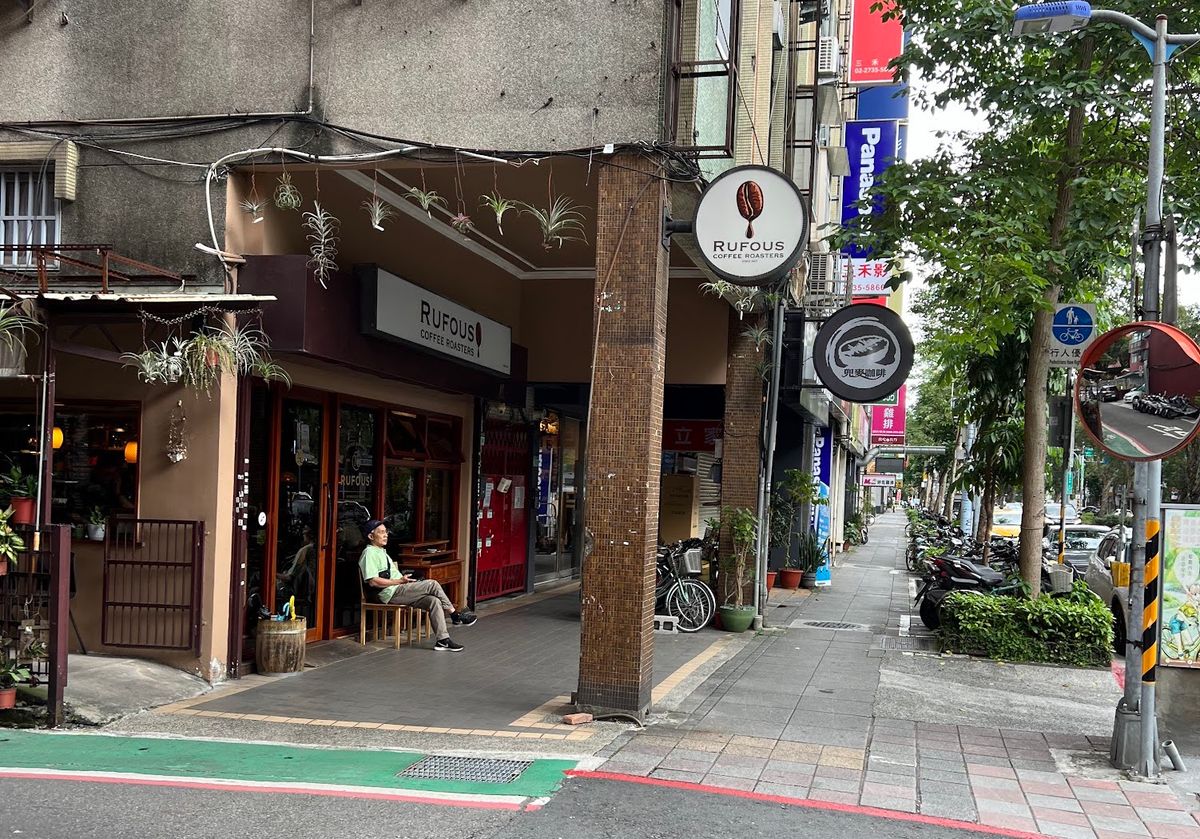
Last year, some friends were planning to visit Taipei and asked me for advice, so I slapped together some tips on how to get around from my trip there in May 2023. This post was sitting around collecting dust for so long that it's probably out of date, so I figured I'd just post it. I'm not really qualified to give advice because I'm not local nor do I go there often, but I wrote down what I figured out, and now I pass it along to you.
The Basics
You can expand each section for more details.
Same power outlets as the US (110V and plug shape). ⚡️ 🔌 ✅
You generally won't need an adapter, though you may want to check if an outlet is explicitly labeled as 220V (e.g. there was one in my hotel bathroom).
Drive and walk on the right side of the road. 🚘 ⇆ 🚶♀️
- Same as US, opposite of Japan/Singapore/UK.
- People don’t tend to jaywalk (at least in the city center). YMMV. Cars and mopeds will try not to kill you, but just barely. Watch out for yourself.
Most people speak Mandarin Chinese and speak varying amounts of English. 🀄️💬
- It's probably closer to Japan than Singapore in this regard.
- Written script is traditional Chinese.
- Like many other Asian countries, signs in Chinese are sometimes written right-to-left, and other times left-to-right.
The currency is the New Taiwan Dollar, abbreviated NTD. 🆕 🇹🇼 💲
As of February 2024, the conversion rate is roughly 31 NTD to 1 USD.
- 100 NTD ~= $3
- 1000 NTD ~=$30
- 3000 NTD ~= $100
Credit cards and tap payments are accepted in many places, but you will likely need at least a bit of cash for various things like:
- Adding value to the metro card (called an EasyCard).
- Many stalls in night markets are cash only.
- Many small stores will only accept cash or QR code payments that you can’t use as a tourist (e.g. LINE Pay).
- It’s not always obvious whether a store will accept credit cards (unless they have a sign somewhere), and I’ve encountered at least one place that accepted physical cards but not Apple Pay. Bring a physical card as backup, and bring some backup cash.
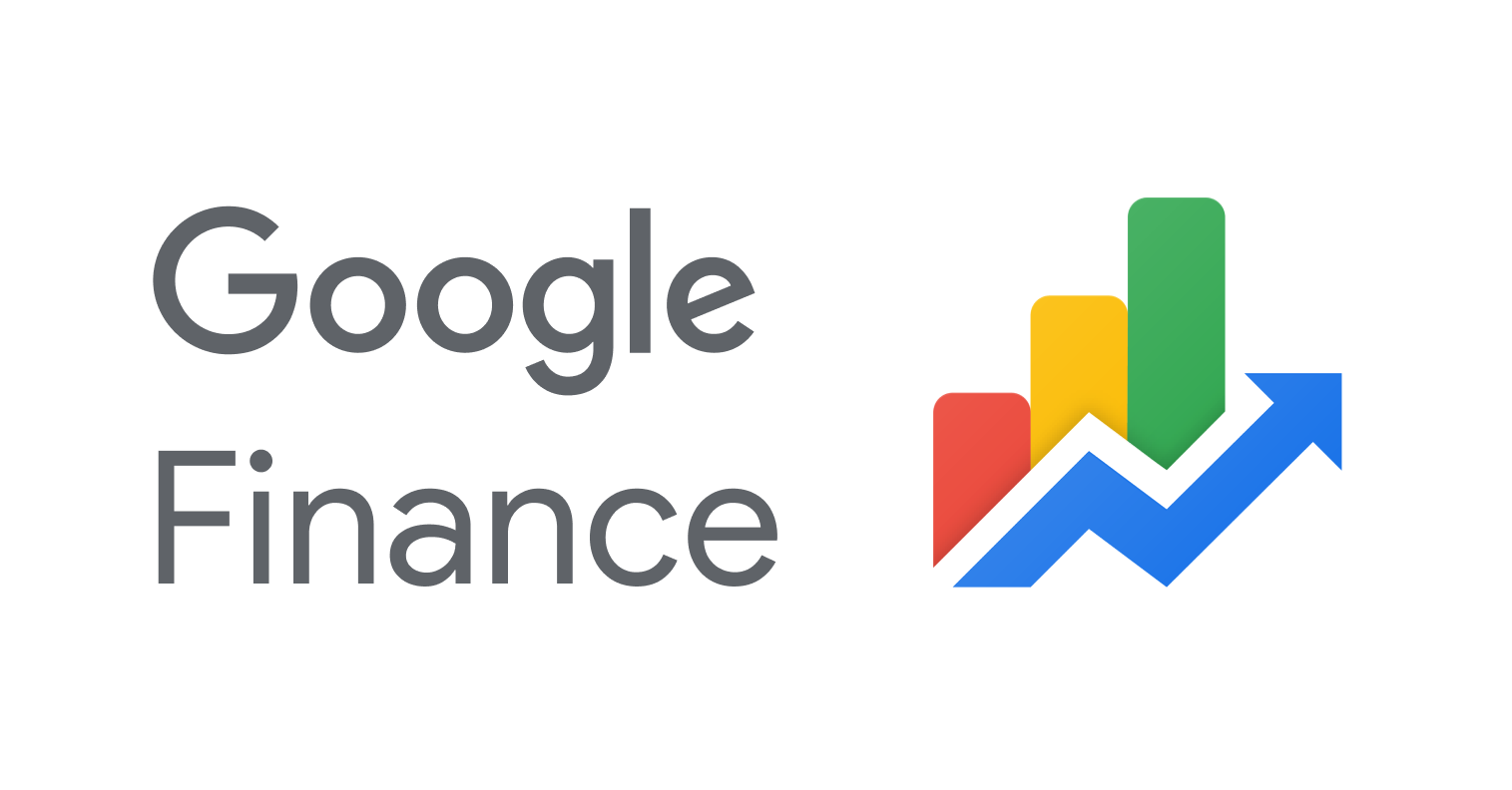
Tipping is very limited in Taiwan. 💸 🧧
This is what I got from observing and parroting things I found on the internet, so don’t take this as gospel because I’m definitely not a local.
- Many restaurants include a 10% service charge and tipping on top of this is not expected.
- For taxis/Uber (more on this later), extra tip is not required, however it’s common to round up if the amount is close to a nice number (e.g. if paying a taxi in cash and the bill is 88 NTD, give them 100 NTD and tell them no need to give change). Even Uber only prompts you to tip 10-30 NTD ($0.33 - $1.00).
- Tip hotel housekeeping staff by leaving money on the pillow the end of the stay. Money on the pillow is a signal that this is a tip. Unsure what an appropriate amount is, check the internet.
- Also it may be good to tip bellhops if they bring your bag to your room, but idk how or how much.
Cafes and restaurants all have different procedures for paying the bill. 🧾✍️ 🤷♂️
- Often, they’ll seat you first and take your order, then you walk up to the counter to pay when you’re done.
- At some cafes, they’ll seat you first, then you walk over to the counter to order and pay.
- At other places (e.g. small restaurants in night markets), you may have to order and pay in the front where they make the food, then seat yourself.
- Sometimes, they’ll come to your table when you’re done and take payment at the table with a credit card reader (though my impression is that this is less common).
- When in doubt, just ask. It’s not as standard as in the US.
Things To Do
Honestly I'm not a great guide for what to do in Taipei as I usually have other obligations to attend to when I'm there, so any free time I have is spent shopping and trying new food.
National Palace Museum
If there's one cultural thing I'd recommend, it's seeing the National Palace Museum. It's one of the world's largest collections of Chinese historical art and artifacts. But also, it's Taiwan so their most famous items are two pieces of jade that look like food. Be warned, it's a bit far from the city center, so it'll take a while to get to and from, but it's reachable by public transit.
Taipei 101
The area around Taipei 101 is a shopping and office district. There are restaurants and shops around it, and it's a decent place to walk around for a bit, but I'm not sure what else to do around there besides eat and shop. There's probably an observation deck you can visit too but it's not really my thing. I feel like I pop by when I visit Taipei just out of obligation, but it's not that memorable.
Ximen (西門)
The shopping area around Ximen station is probably more touristy/hip than the bigger stores by Taipei 101. There's a lot of food, clothing, and some lifestyle stuff like stationary and arcades (?). It's a decent place to walk around.
Getting Around
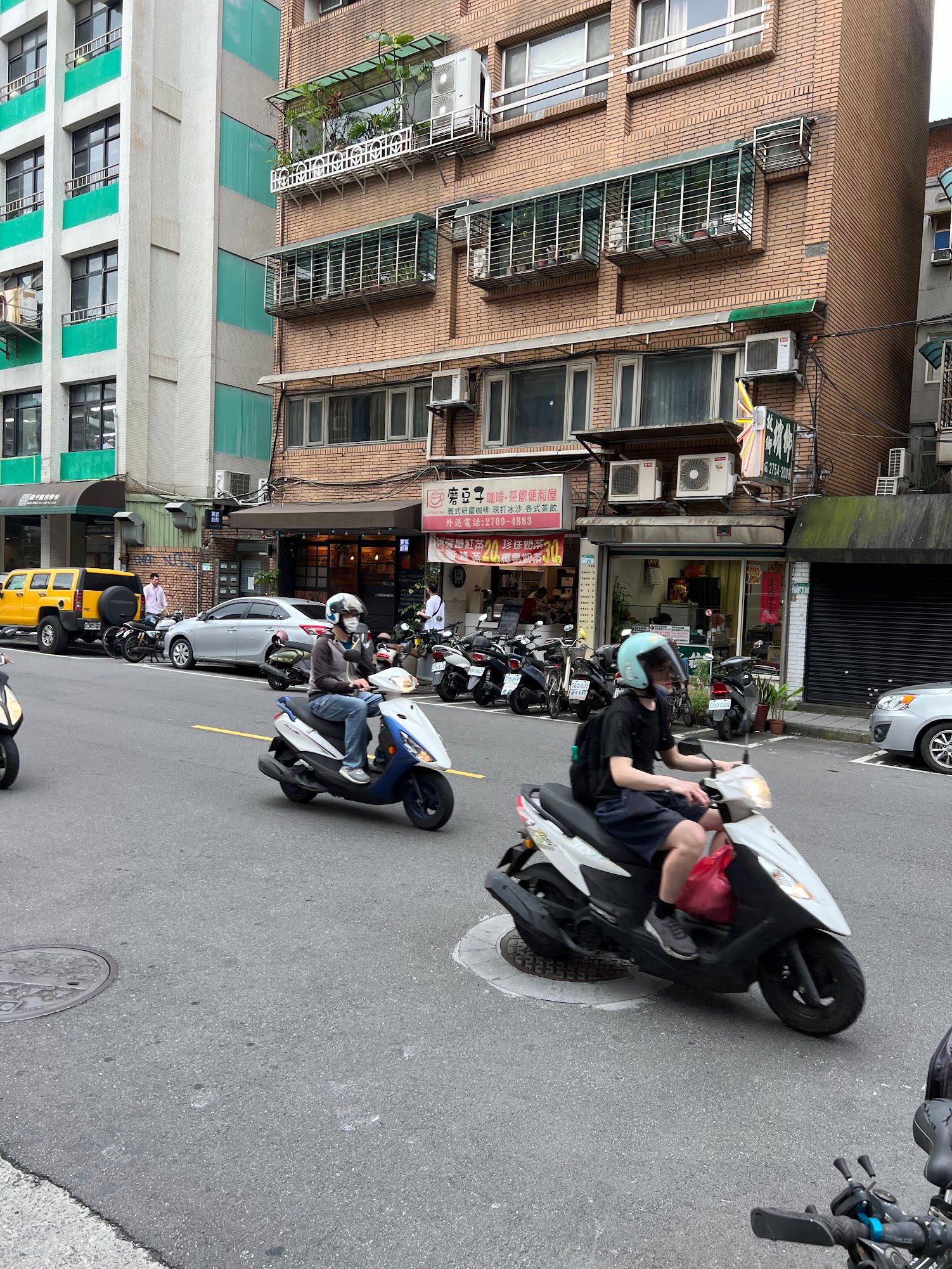
Overview
- Public transit in Taipei is really good. You can get almost everywhere efficiently using the subway (called MRT) and bus system. The city also has a bike-sharing program called YouBike that’s easy and cheap to use (once you set up the app), with good Google Maps integration.
- Uber works in Taipei and integrates with the local taxi system. Getting around via taxis/Uber is cheap and efficient, and is a good way to move around the city in ways that cut across the MRT routes.
Getting an EasyCard (the local metro card)
- The local metro card is called EasyCard. It's a stored-value card that holds a balance of NTD that gets deducted when you tap in and out of public transit. Like Tokyo’s transit cards (Suica/Pasmo), you can also use them to pay at certain shops, like 7-Eleven, McDonalds, etc.
- The easiest way to get an EasyCard is to buy one in an MRT station. There’s a separate machine for getting a card vs adding value. You’ll need cash for this, and a new card usually costs 100 NTD. This only covers the cost of the card and doesn’t include any stored value, so you’ll want to add some more value after that (e.g. 100-200 NTD at a time depending on how long you’re staying).
- You can also buy an EasyCard at 7-Eleven and other convenience stores. You can buy the EasyCard itself with a credit card if you buy it at a convenience store, but you’ll still need cash to add value to the card, even in a convenience store.
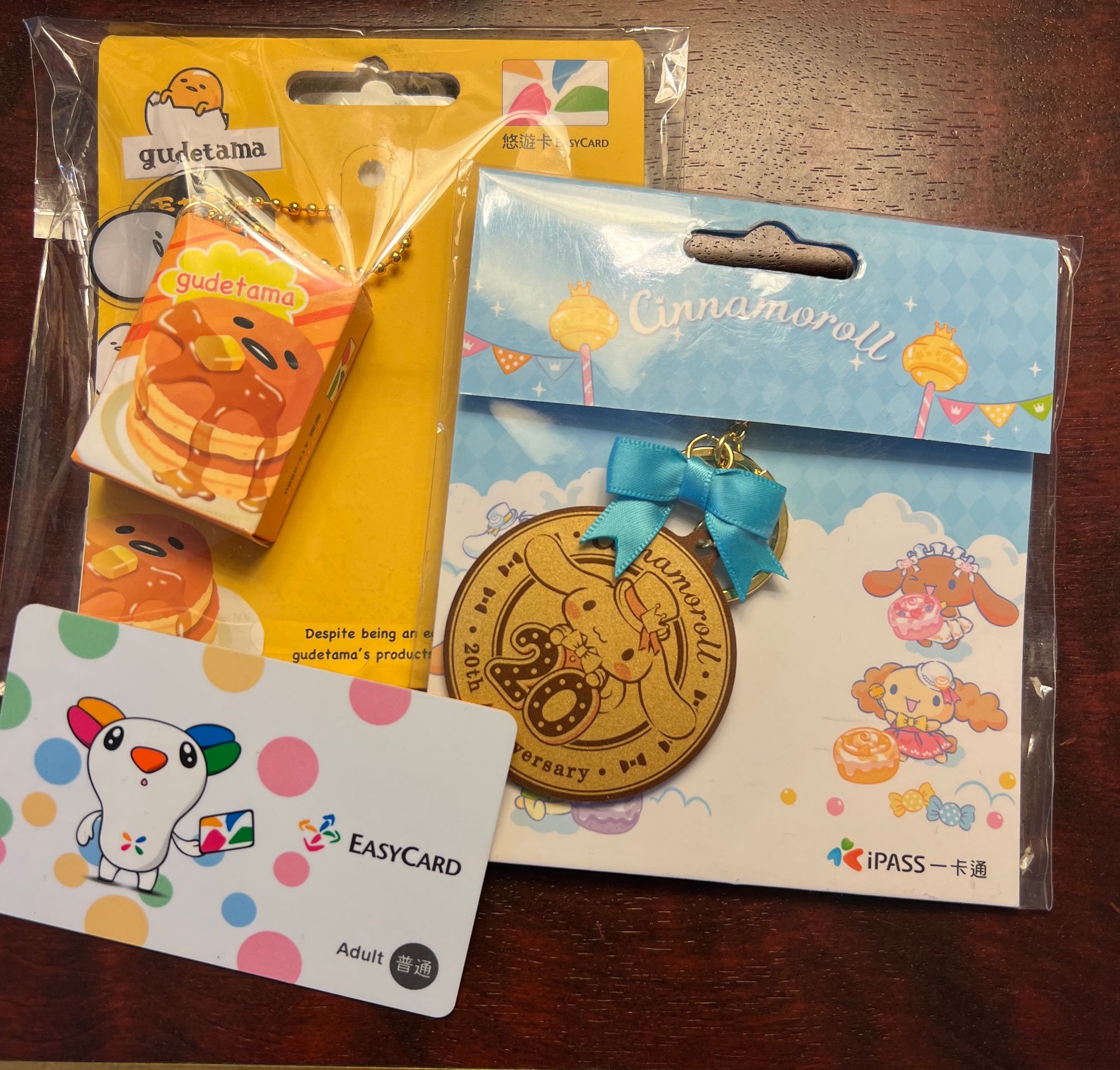
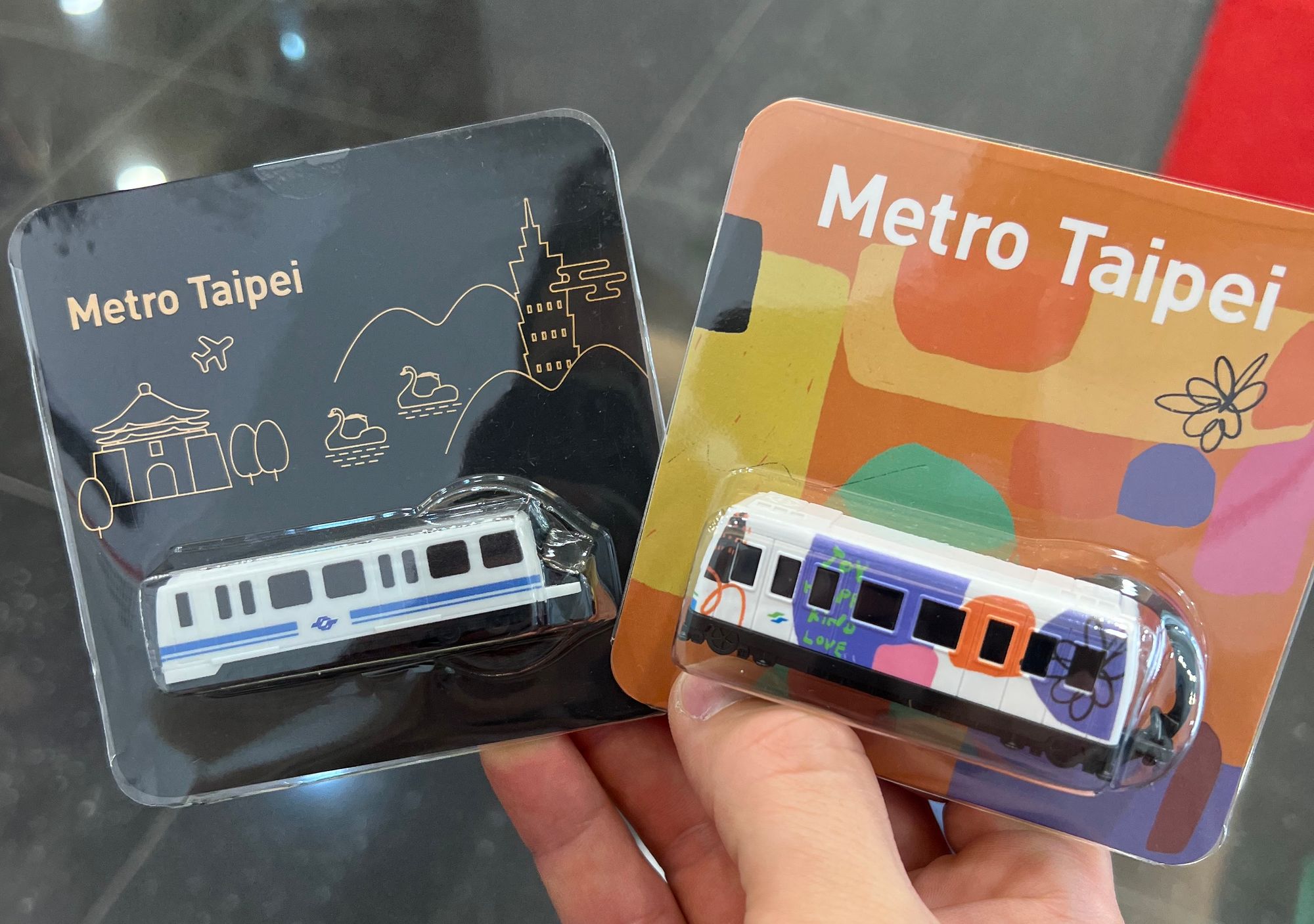
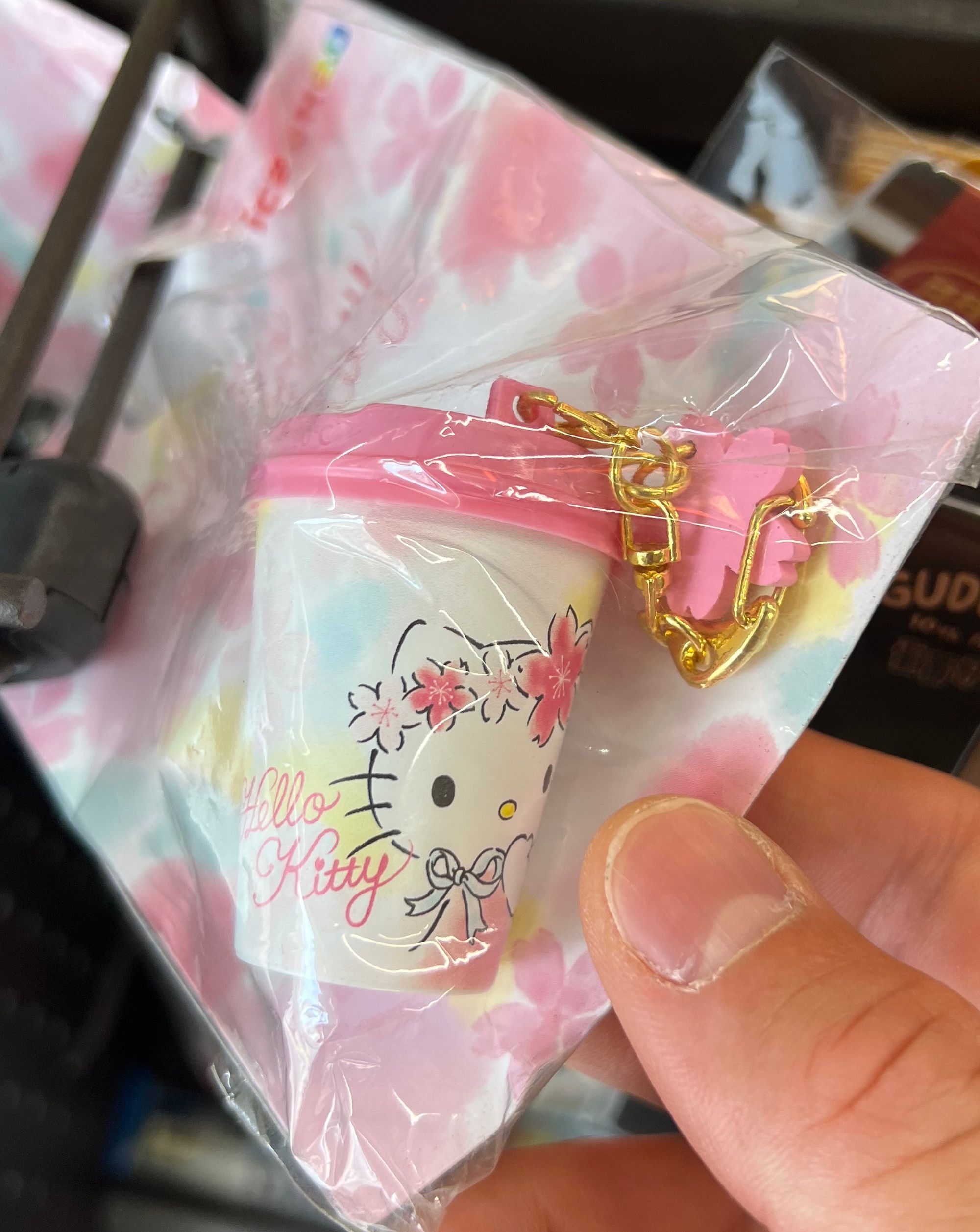
These are all valid metro cards. First Image: On the bottom, a classic EasyCard. On the right, a Cinnamoroll (Sanrio) keychain that's an iPASS card type. On the top, a Gudetama (also from Sanrio) mini pancake box keychain. Second Image: Two model subway car keychains that light up and make sounds. Third Image: a Hello Kitty coffee cup keychain. It's hard to see bit in the top right corner of the cardboard backing, it shows that it's an iCash 2.0 type card.
Types of EasyCards (You Don't Actually Need to Know This)
There are a few different “types” of EasyCards that are interchangeable, sorta like how Tokyo has Suica and Pasmo. The differences between them are negligible for a tourist, and you’ll likely just get the normal “EasyCard” and not need this info at all. Regardless of what kind of card you get, it'll work on public transit and as a payment method at some convenience stores, so don't sweat it.
- EasyCard: branded with the EasyCard logo, these have the highest compatibility and work on transit, certain shops, and for YouBikes (but NOT for tourists b/c you need a local number to use an EasyCard to rent YouBikes – see workaround below).
- iPASS: works pretty much identically to an EasyCard
- iCash 2.0: works on transit the same way EasyCard does, but does NOT work for YouBikes. (Again, see workaround below).
7-Eleven sells EasyCards in cooler/cuter forms than the usual credit-card form factor that the MRT station vending machines sell:
- There are keychains and pendants
- Novelty items like miniature bottles, coffee cups, and candy boxes.
- My personal favorite, a miniature version of the Taipei MRT trains that lights up and plays the door-closing chime when you scan it (using NFC power – there’s no battery, and you can trigger it with your phone).
This is the elevated track style train cars (sorta similar to an airport inter-terminal train), and it plays the "station approaching" chime.
Call A Car: Ubers and Taxis
- Hailing taxis on the street is safe and convenient… if you know how to describe where you’re going in Chinese. Otherwise, just use Uber so that the driver gets the address without you having to explain it in Chinese. If you do try to hail a taxi, look for ones with a lit up red sign that says “空車” (empty car).
- I don’t know how you pay for taxis these days. IIRC, they prefer cash but you can pay for most with a credit card or EasyCard.
- Uber doesn’t seem to cost much more than calling a taxi directly, so I recommend doing that.
- A 5-10 minute taxi ride can save you 30 minutes getting around on public transit if your origin or destination aren’t close to a good MRT route. A ride of that length will cost you around 100-200 NTD (~$3-6 USD).
- Often times, taxi drivers will confirm your destination (in Chinese) by checking the street and section with you. For example, you might be going to a location near Fuxing South Road, Section 2. I have no idea where my destinations are in terms of streets and sections, so I just use Uber and then nod when they ask. Dunno if that’s the best advice, but I've managed to get to my destination every time so far.
How to Use the YouBike Bike Sharing System
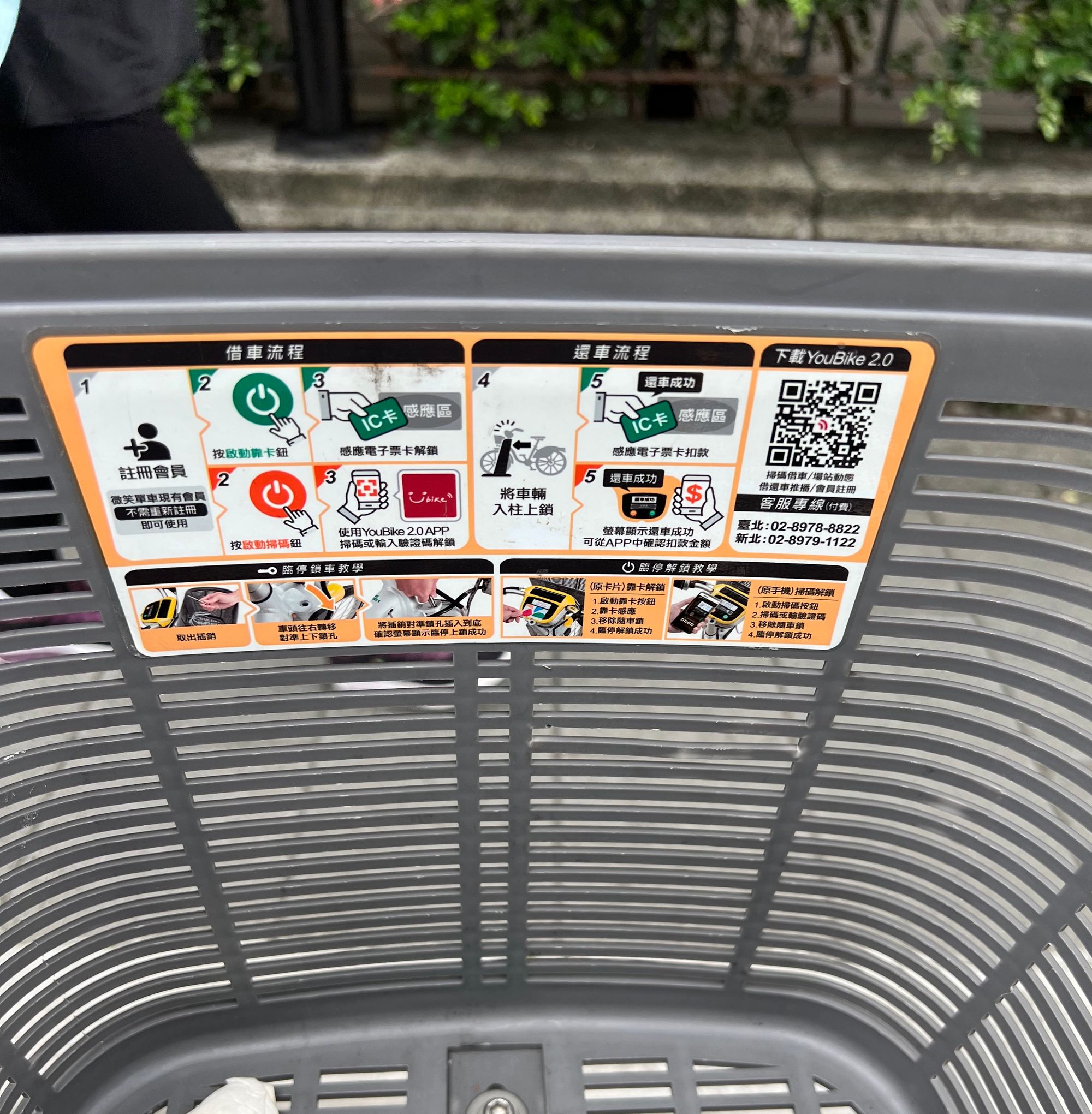
- There are YouBike docks stationed all over Taipei. You have to check out a bike from a dock and return it to one to complete your ride.
- Google Maps knows where they are and integrates with the YouBike app to tell you how many bikes are docked at each station in real time.
- Taipei has dedicated bike lanes on the sidewalks which makes it safer and more comfortable to get around by bike. It’s a bad idea to bike on the road (unless it’s down a small alley – I wouldn’t do it on major streets). The sidewalks along major streets are usually very wide, with a covered walkway extending out from the storefronts and an uncovered part on the road side. Typically, pedestrians walk in the covered part, and bikes go along the uncovered bit, but people weave all over the sidewalks, so be alert.
- Locals usually register their local phone number and EasyCard so they can just tap to unlock a bike. Tourists can’t do this without a local phone number, but they can still unlock bikes using the app.
The workaround is to get the YouBike app and use an alternate setup to allow you to unlock bikes with the app for 5 days at a time (after which you’ll have to re-register):

iOS
Android
- Download the app (you can pick English somewhere, I forget where).
- Go to the registration page. On the bottom, there’s a link that says “Single Rental”.
- Confirm your email address and add a credit card. They’ll put a ~$100 USD hold on your card as a deposit, which is refunded after the 5 days ends.
- You can use the app to scan the QR code on the bike (or enter the 4 digit bike number) to unlock. On a YouBike 2.0 (the yellow ones?) there are two buttons – a green one for unlocking with an EasyCard, and an orange one for unlocking via QR code/number. Hit the orange one and scan the QR code (or type in the 4 digit number) in the app.
- Once the bike is unlocked, pull the bike back away from the dock.
- Remember to re-dock the bike when you’re done. This locks the bike and stops charging you. There’s a metal lock block on the bike that slides into a slot in the dock.
- Bike use is charged in 30 minute increments. The marginal rate goes up the longer you rent it (it’s meant for short term rentals). The first 30 minutes costs something like $0.33 USD.
- After 5 days, you may need to go through this process again.
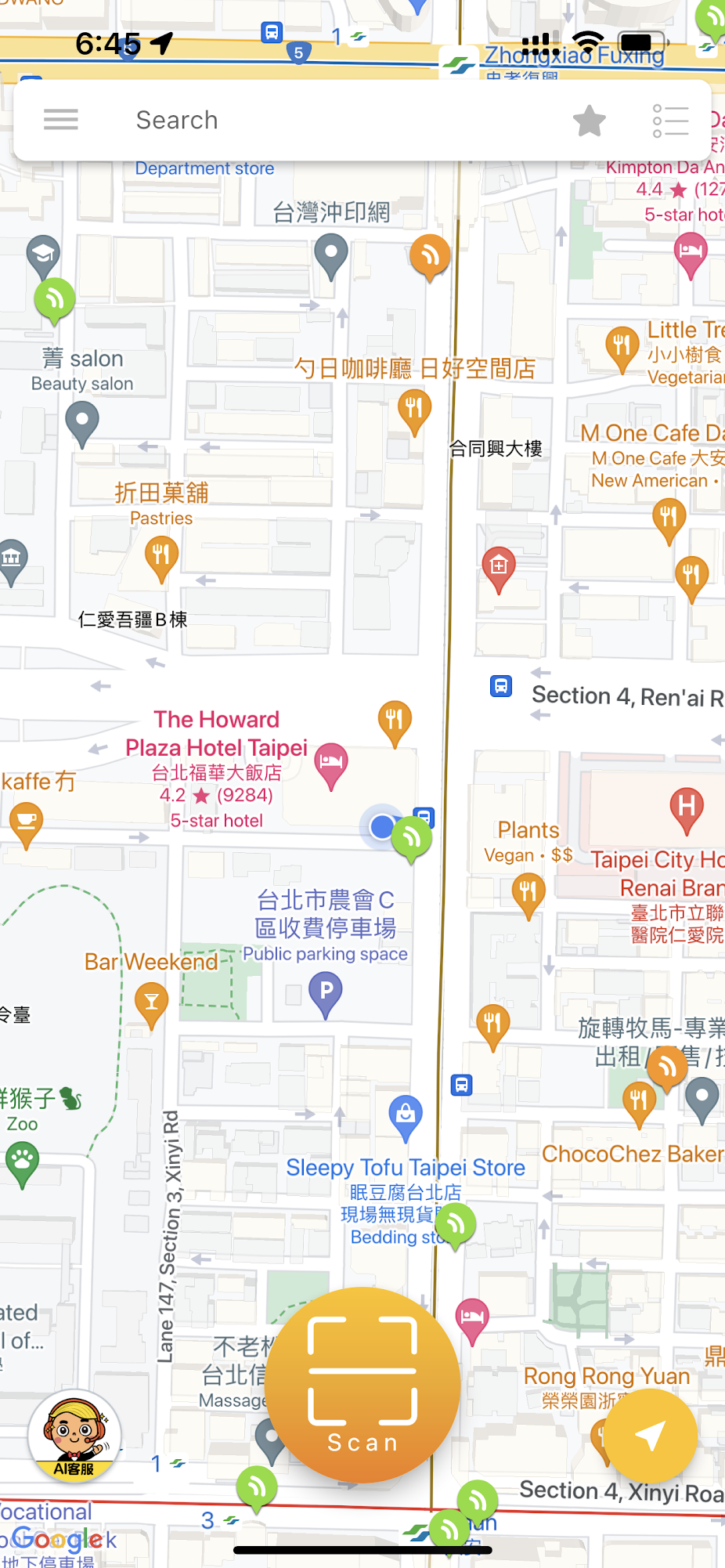
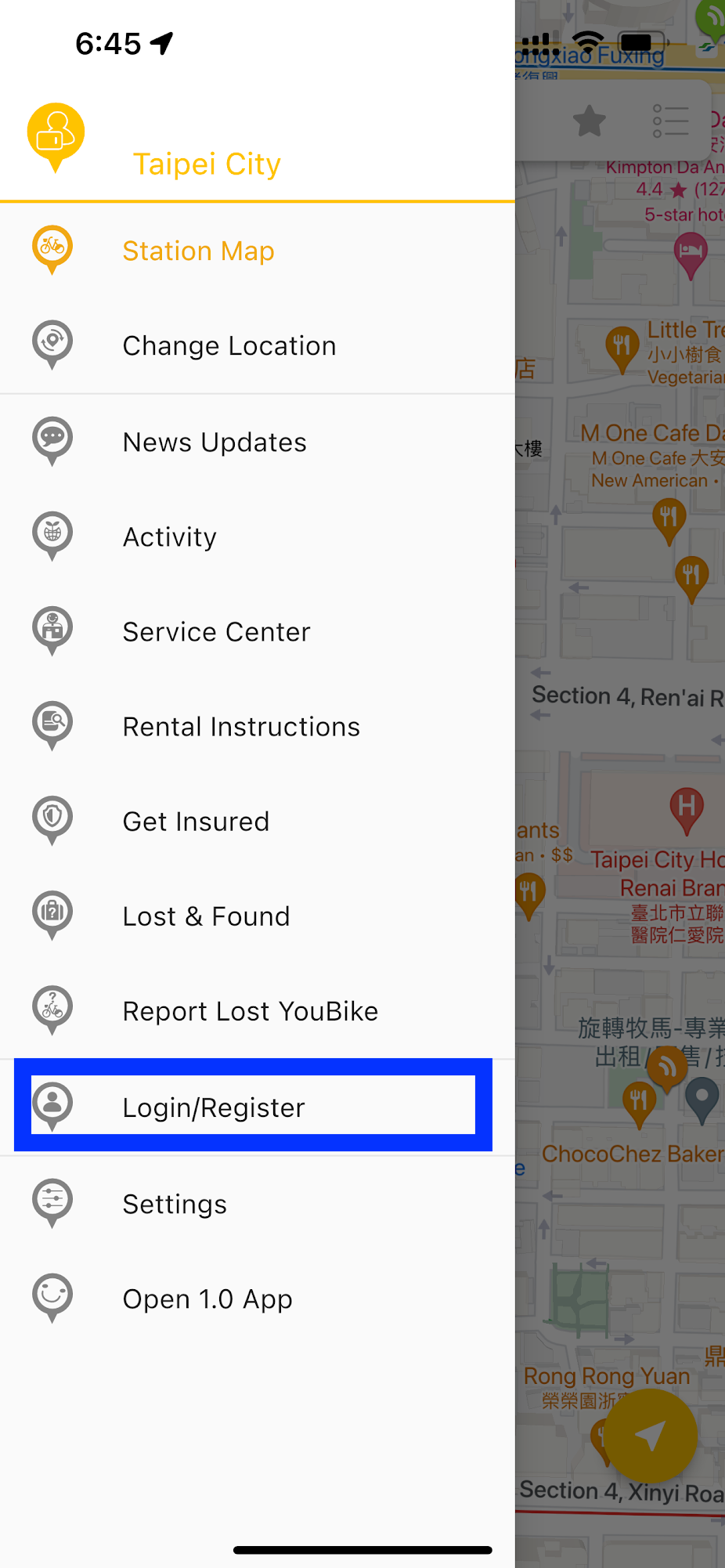
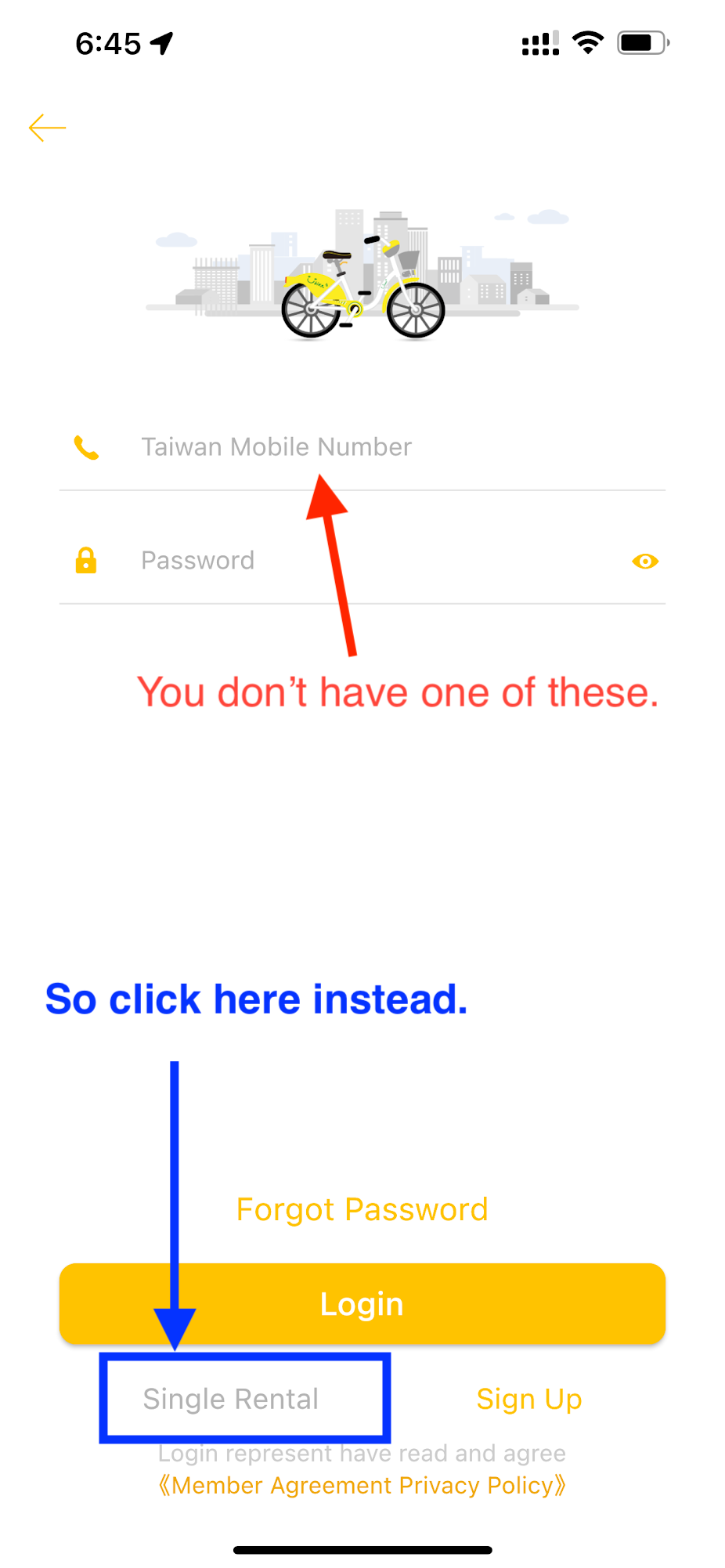
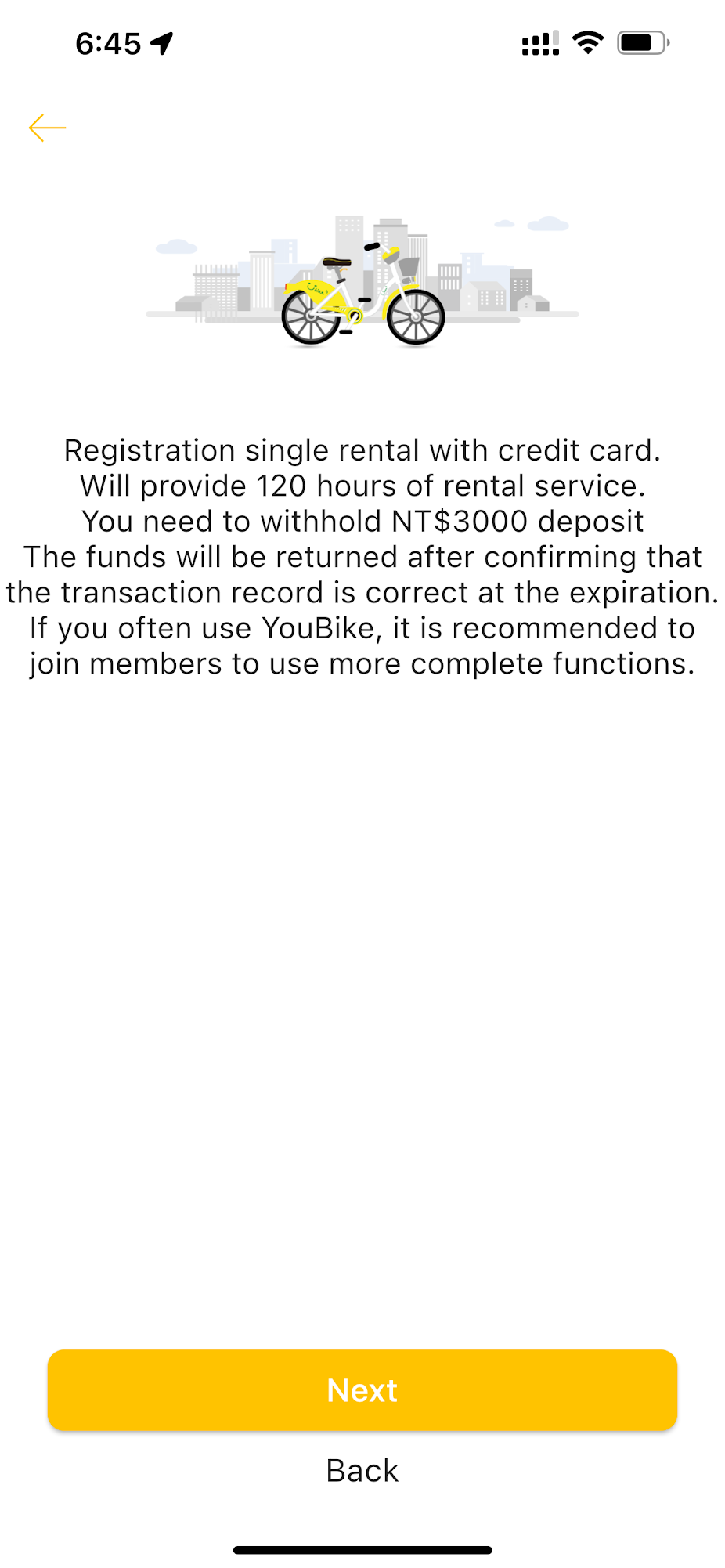
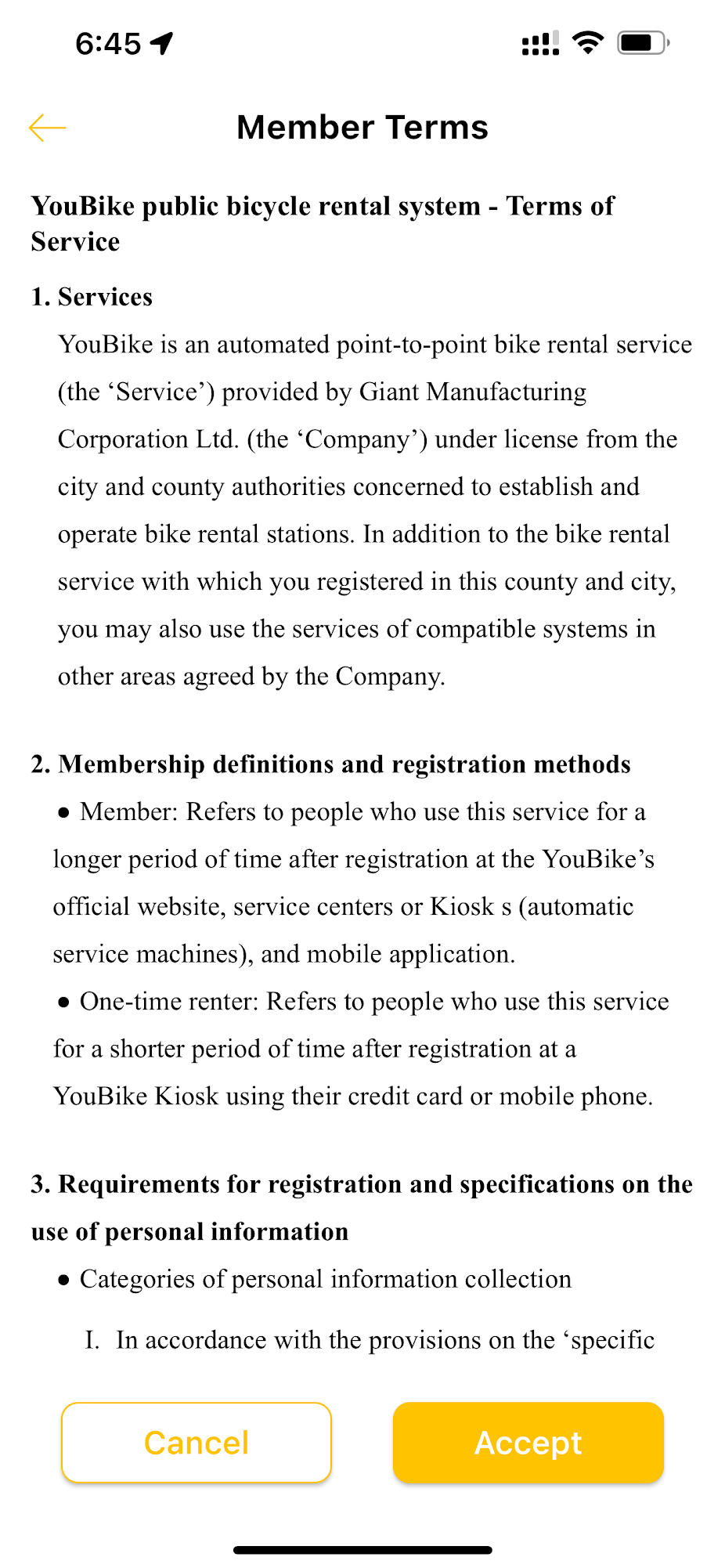
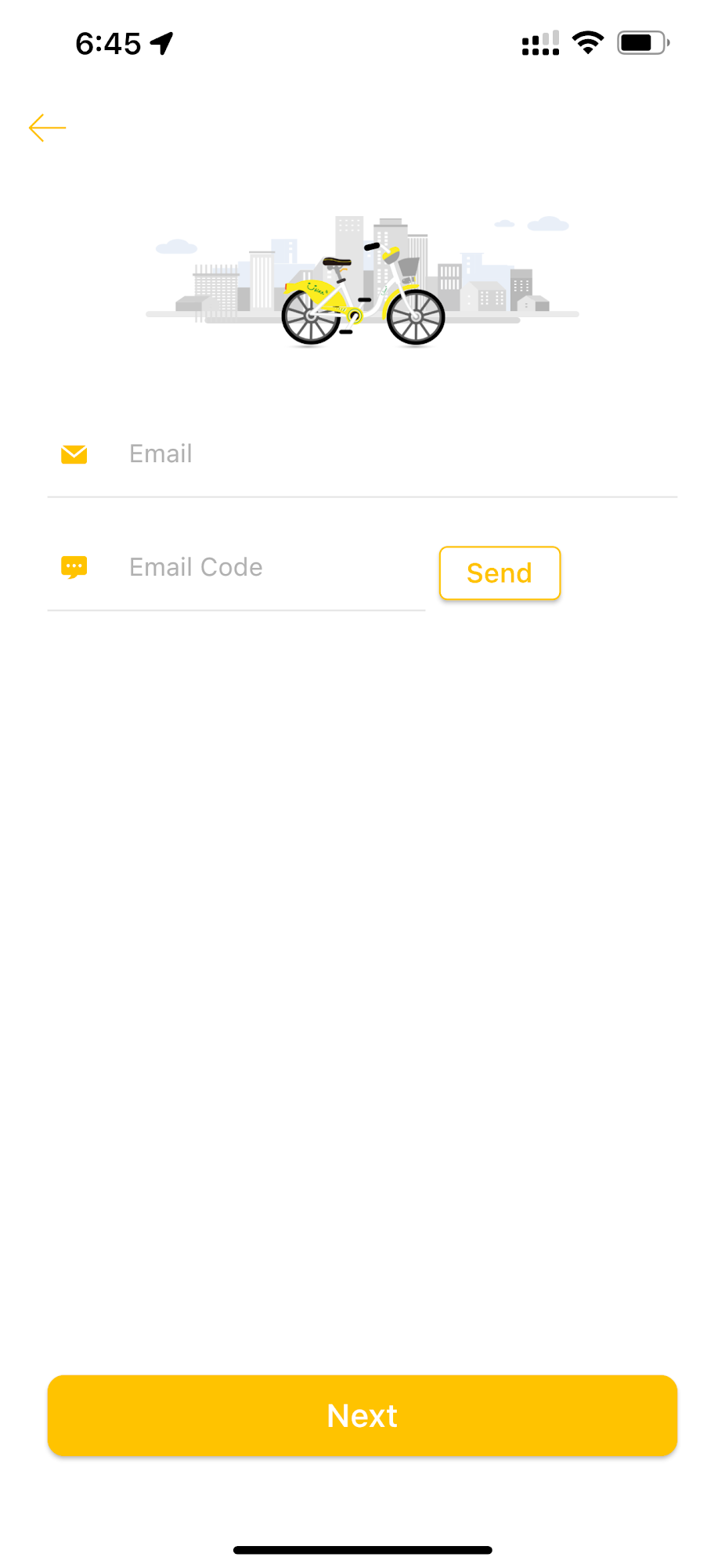
Here are the registration steps, visually.
Quality of Life Tips
Dealing with the heat and humidity
- When it’s hot, walk slower and carry less. This sounds pretty obvious, but I tend to be a pack mule when I travel, and this doesn't work out well in the heat and humidity of Asia.
- There are 7-Elevens and Family Marts everywhere, so it’s usually easy to get a drink during the day.
- Wear face sunscreen. The Biore UV sunscreen is readily available and pretty good.
Download some apps beforehand
- Google Translate (iOS, Android): Download the Chinese (Traditional) offline data. The camera translation is really nice.
- YouBike 2.0 (iOS, Android): you need this to unlock bikes, and it’s like a 100MB download.
- I recommend downloading a map of the Taipei Metro as a photo on your phone for easy no-internet access. You can download a copy here.

Know where things connect underground (and via covered walkways above ground).
- For example, there’s an underground mall linking the Zhongxiao Fuxing station and the Zhongxiao Dunhua station.
- There’s a way to get from City Hall Station to Taipei 101 through indoor, underground, and elevated walkways.
The non-standard EasyCard form factors are really cool.
- Every 7-Eleven seems to have a different selection of them, so I popped into them sometimes to check for anything new or unique. They tend to be near the register. The fun ones don’t look like cards, so it might not look the way you expect. Look for the EasyCard (or iPASS or iCash) logos on the top right of the packaging to see if something is a transit card, even if it looks like a stuffed toy.
- If you get something that’s not a credit card form factor, you can hang it on something for extra convenience. For example, if you get a keychain, you can hang it off your bag, or if you get a mini oolong tea bottle like I did, you can get a small retractable clip for it from a 7-Eleven or stationary store and clip it to your waist.
- I got the mini-MRT train EasyCards in the Metro Shop inside the fare area of the Zhongxiao Fuxing MRT station. It’s not on Google Maps as far as I know, but it’s inside the fare area, immediately before the escalator going up to the Brown line, on the right side. It’s immediately behind the Cremia (a Hokkaido ice cream shop that’s pretty decent, and is on Google Maps), but inside the fare area, so you’ll need to go through the gate and go around.
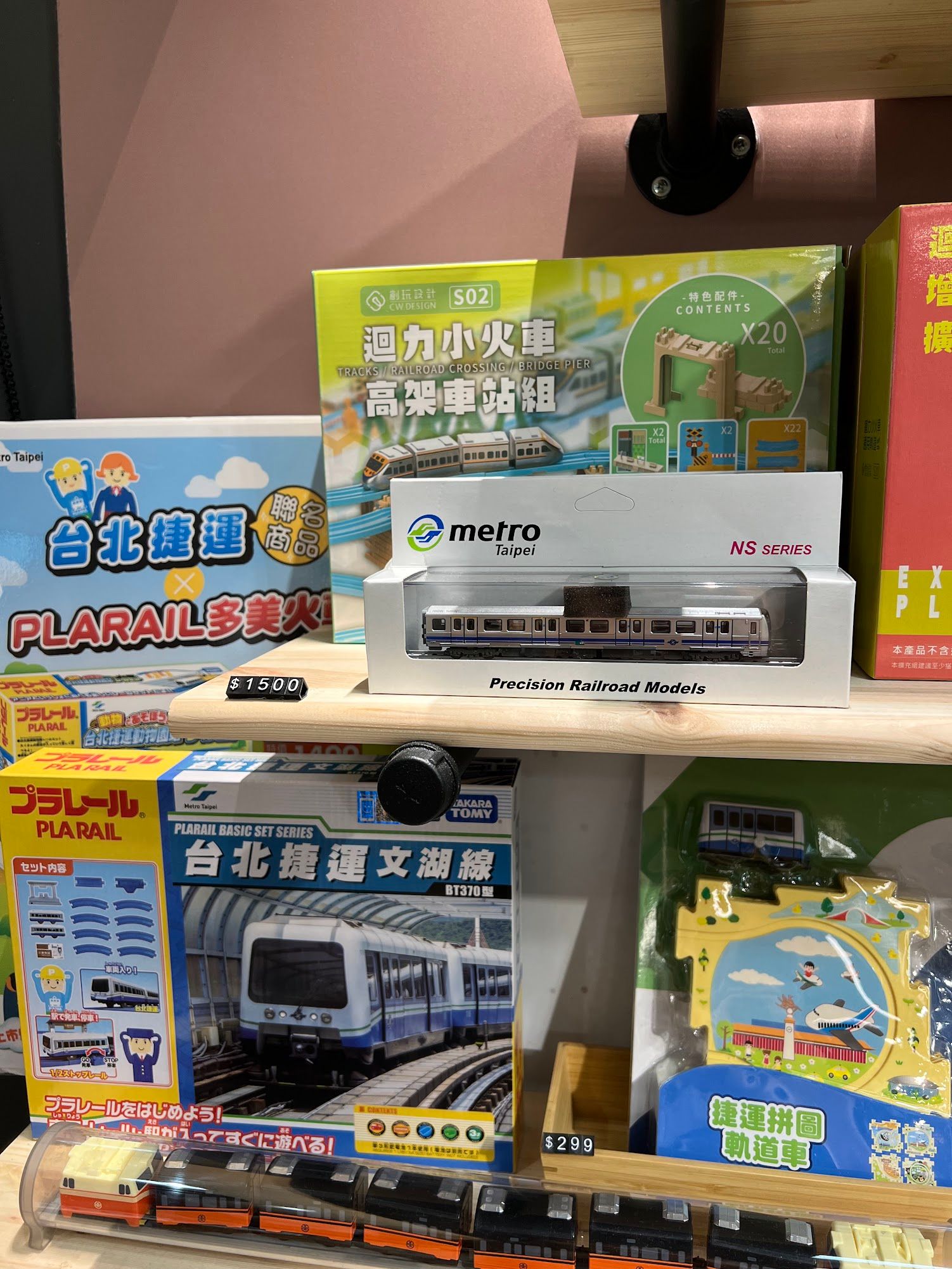

Seriously, this Metro Shop is a transit nerd's dream. It's got a lot of Taipei Metro themed toys, models, accessories, etc. I got a hankerchief with the metro map on it and some gatcha balls with models of "views from the Yamanote line" (in Tokyo).
The "secret" Metro Shop is behind this Cremia. Just go into the fare area and walk slightly past the back of the Cremia and you should see it.
Bring your passport with you when shopping to get a tax refund.
- You can get a tax refund of about 4% on certain items you purchase that you intend to export from Taiwan.
- Technically, the refund amount is higher (5%), but most department stores take a 20% processing fee, so you net out to ~4% of the purchase price refunded.
- This usually only works at department stores and malls. For example, a Uniqlo or Muji in a mall will usually participate in the mall's tax refund scheme.
- Most places require you to spend at least 2000 NTD (~$60) in combined receipts at that department store or mall within a single day. You can reach that amount by shopping in different shops (so individual transactions can be less than 2000 NTD), but it usually has to be on the same day.
- You can only get a tax refund on items you’re exporting (or feasibly could export). Most importantly, this means you can’t get refunds on things like food that are consumed in Taiwan (though I think you can still get some food items refunded if you export it instead of consuming it). Things like clothes, electronics, and souvenirs are prime candidates.
The process is:
- Bring your passport when you go shopping.
- When you check out, ask if they have a tax refund. They need to prep the receipt for you to get you the refund, so let each store know when you check out. Also, they may need to split your cart into multiple transactions if some items qualify for a tax refund but others do not.
- Ask where the tax refund counter is. Usually they’ll tell you what floor and you just go find the customer service area on that floor.
- Take all your receipts and the items you bought to the service counter (usually take a number, or if there’s no line, say “Tax Refund” and they’ll direct you to the correct station). Give them your passport and receipts.
- They may inspect your items to make sure that you purchased what was listed and that items qualify for a tax refund.
- You may get a refund in one of two forms:
- Cash: they’ll hand you cash on the spot
- A voucher that you need to take to the tax refund counter at the airport to collect your refund when you leave.
- Either way, you need to keep your documentation with you and the items that you claimed the refund on. The government does random inspections of tax refund claims at the airport to make sure people actually exported the items they claimed a tax refund for.


